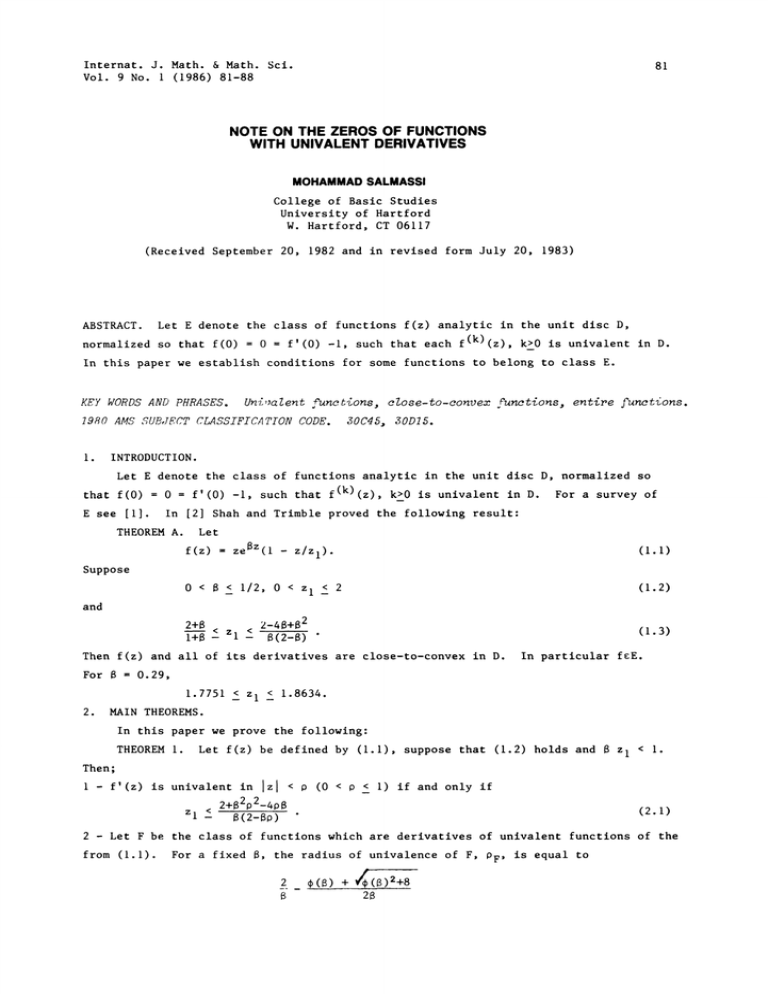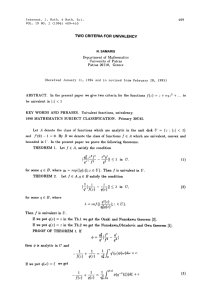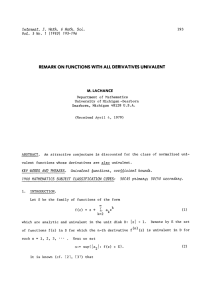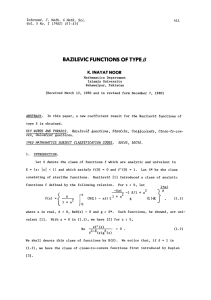Document 10507960
advertisement

Internat. J. Math. & Math. Sci.
(1986) 81-88
81
Vol. 9 No.
NOTE ON THE ZEROS OF FUNCTIONS
WITH UNIVALENT DERIVATIVES
MOHAMMAD SALMASSI
College of Basic Studies
University of Hartford
W. Hartford, CT 06117
(Received September 20, 1982 and in revised form July 20, 1983)
ABSTRACT.
Let E denote the class of functions f(z) analytic in the unit disc D,
normalized so that f(0)
f’(0) -I, such that each
0
f(k)(z),
k>0 is univalent in D.
In this paper we establish conditions for some functions to belong to class E.
KEY WORDS AND PHRASES. Uni,alent functions, close-to-convex functions, entire
1980 AMS SUBJECT CLASSIFICATION CODE. 30C45, 30D15.
I.
functions.
INTRODUCTION.
Let E denote the class of functions analytic in the unit disc D, normalized so
f(k)(z),
f’(0) -I, such that
k>0 is univalent in D.
that f(0)
0
E see [I].
In [2] Shah and Trimble proved the following result:
THEOREM A.
For a survey of
Let
zeBZ(l
f(z)
Z/Zl).
(1.1)
Suppose
B
0 <
1/2, 0
<
< z
(1.2)
< 2
and
2+B <z
<
I+B
2-4B+B 2
(1 3)
S(2-B)
Then f(z) and all of its derivatives are close-to-convex in D.
For
1.7751
2.
In particular fEE.
0.29,
_<
z
_<
1.8634.
MAIN THEOREMS.
In this paper we prove the following:
Let f(z) be defined by (I.I), suppose that (1.2) holds and B z
THEOREM I.
< I.
Then;
f’(z) is univalent in
Zl
2
-<
Izl
0
(0 < O < I) if and only if
2+B202-4pB
(2.1)
B (2-Bp)
Let F be the class of functions which are derivatives of univalent functions of the
from (I.I).
For a fixed B, the radius of univalence of F, O F
2
B
(B) +
(B)2+8
2B
is equal to
M. SALMASS I
82
where
()
THEOREM 2.
Let
f(z)
1+6
be defined by (I.I) and suppose that (1.2) holds.
2+8
I+6
-6+8(6-82
<
< z
If
(2 2)
6
then f(z), f"(z), f"’(z)
are close-to-convex and consequently univalent in
In particular if 6
0.4766, 1.6781 < z < 1.6791
In addition, if
2+62_46
2+6
6(2-6)
THEOREM 3.
then
f’(z)
is not univalent in
0
6
D.
Let
f(z)
Suppose
D.
ze
6z(l
z 2/z
2)
(2.3)
0.4 and
6+82+68
82+28
2-66+362
82
z, 2
(2.4)
in
f(z) and all of its derivatives are close-to-convex and consequently univalent
D
In particular for 6
z
0.2314, 3.79664
3.7978
3.
PROOFS.
Then
6z
PROOF OF THEOREM 1.
(1.2), iS convex in
D.
Proof of sufficiency.
will be close-to-convex in
If
o(x)
Izl
E 0
{2(6
1___)
Zl
+
f"(z)
g (z)
+ 8(6
Zl
on
Izl
4___)
x
Zl
By the maximum principle it suffices to prove that
For simplicity we write
0(x)
0
Izl
for
6
as in
then
f’(z)
B
E 0
and consequently univalent there (see [3]).
denotes the real part of
0 (x)
f"(z)
Ret,
If we can show that
--Cl
g(z)
The function
ax2+bx+c
0
where
x
Rez
then
282x2
I
O(x)
Observe that
0
b2-4ac
for
O.
x
in
Thus
[-1,13.
0(x)
has two real roots, and we will be done if we can show that
-b-/-4ac
(3.1)
2a
(The larger root of
(x)
is
See fgure I).
2a
-
.
Figure I.
(x)
ZEROS OF FUNCTIONS WITH UNIVALENT DERIVATIVES
Stnce a<O,
_
83
t. 1) in equivalent to
Zb2-4ac
2ap-b.
(3.2)
From the definition of a and b we have
B[ g
2ao-b
40)
B(I+
B
4-BZl-40B
z
>
4-I-2
z
z
> 0
and (1.2) holds.
since 0
Squaring both sides of (3.2) and simplifying we get
4ao(ao-b)
-4ac.
Divide by 4a which is negative to get
o(b-ao)
c.
Using the definitions of a, b and c, this becomes
zlB(BO-2)
B202-2.
4B0
From this, noting that 60-2
2+6202
Zl
O, we conclude that (3.2) is equivalent to
460
6(2-6p)
which is (2.1).
We show that if
Proof of necessity.
2+620 2
zt
-460
(3.3)
6(2-06)
then f"(z) has a root in
Izl
< 0, which means that
f’(z) is
not univalent there.
The
equation, f"(z)= O, that is
-62
nz 2
Zl
(-46
2
--I + 62 )z+26
+
0
z
has two negative roots given by
,/’IB2+8/zI2
6-4/z
26
zl
The smaller root lies in the disc
16-4/zI
/2+8/z1 2
+
< O.
28/z
/’62
-4__)
z
+
(3.4)
(3.4) is equivalent to
Since the roots are negative
-(6
< 0 if
8/Zl 2
<
260
z
or
260
4
-6+ z
z
/62
+
8/Zl 2
(3.5)
But
6 +
4
260
z
z
by (1.2) and 0_<I.
4-6z
2613
Zl
2
z
Squaring both sides of (3.5) and simplifying we get (3.3).
This proves the first part of the theorem.
To prove the second part note that by
definition, O F is the largest number such that g(OFZ) is univalent for all geF in D.
Let geF. Then g
f’ for some f of the form (I.I). In [2] it is shown that f is
univalent in D, given (1.2), if and only if z
.
2+6
Og,
the radius of univalence of
M. SALMASSI
84
g, is non zero because f"(0) # 0.
Therefore, by the first part of the theorem, the
condition
2+___
I+8
< z
2+82g
4OgB
8(2-80g)
<
(3 6)
is the necessary and sufficient condition for f(z) and
Let x
x2
g(OgZ)
D.
to be univalent in
It follows form (3.6) that
0gS.
2-
(8) x
0
2
which is true if and only if
(8) +
x
/Q(8) 2
+ 8
2
or if
(8)2+8
(8) +
(3.7)
28
The case of equality in (3.7) corresponds to the case where both inequalities in Q.6)
2+8 is
for which z
That is the radius of univalence of the
are
2
0g
g
equalities.
cisely the expression on the right of (3.7).
corresponds to 8
Note that O F
f(n)(z),
This wiiI show that f(z) and
and z in D.
Also if 8
.29.
f’(z)
We will show that Re{
e 8Z
PROOF OF THEOREM 2
2+8
[2] it was shown that, if (1.2) hoids and ]- < z
we need oniy show that
Re{
f(n)(z)}
eSZ
x
Rez
0 and Re{
0.2793.
f(n)(z)}
8z
0 for n
n-I)
n(X =nn-2(_
The quadratic
Qn(X)
3
e
n > 2 are ciose-to-convex in D.
< 2, then
Re{ f’(z)} 0 in D.
In
Thus
eSZ
3 in D.
f(n)(z)
Qn(X)
where
J and note that
Henceforth we assume that n
positive.
< 0 for n
0.4746, O F
3 by
on the unit circie for n
e 8z
0 for x in [-I,I].
it wiii be sufficient to show that Qn(X)
If we denote the reai part of
pre-
T
This proves the second part of the theorem
n
8
2n)
++n-(_
x
28n
-7 x
2
wiII be nonpositive for aii x e[-I,I] if its discriminant is non-
(We may note that the case when
n(X)
has two reaI roots is not of interest).
Thus we have
82zi 2 + 882
4n[n-(2+Szl)],
n
!
3.
This inequaiity wiii be satisfied if it is satisfied for n
82zi 2 +
128z
-6 +
This hoids when z
Letting 8
Finaiiy if
+
882-12
/8(6-82)
8
3, that is, if
0.
which is true by (2.2).
0.4746, caicuiations show that (2.2) impiies 1.6781
2+82-48
8(2-B)
2+8
$’ then z
the first part of Theorem
f’(z) is
2+82-48
(2 2)
8(2-8) by
not univaient in
D.
Thus if 8z
But if 8z
1.6791.
z
<
then by
I, then f"(0)
and f’(z) is not univaient in D.
PROOF OF THEOREM 3
8
Note that
3-
0.4226 is the smaiIer zero of 2-68 +
0.4 guarantees that the rightmost expression in (2.4) is positive.
382
Let a
-
Thus
z
and
0
ZEROS OF FUNCTIONS WITH UNIVALENT DERIVATIVES
Re{
n(X)
f(n)(z)}
eSZ
on the unit circle where
O,
l(X)
showing that
2(x)
n(X)
0 and
Rez.
x
85
We will prove the theorem by
0 for n
3 and x in [-I,I].
First observe that
-4aSx 3
l(X)
6ax 2 + (3a8+8) x +
+ 3a
and
l’(X)
We will have
-12aSx
i(-I)
+ 3a8 + 8.
12ax
eOand
e 0
i(I)
1-8 e a
if
+I
and
e a, respectively.
But both inequalities are true; this follows from (2.4) and the fact that, for 8 < 0.4,
8+I
I-
B+3
3-8
2B+B
l’(X)
’(-x)= -9aB + 12a +
the negative root of
I ’(x)
has one positive and one negative root.
=
Also, since
a(12-98) + 8 >O,
lies to the left of
-I
(See Figure 2)
x=-I x’l
Figure 2.
Thus
l(X) _>
0 for x in [-I,I].
-4a82
2(x)
x3
Next note that
2(x)
is negative.
82
3(2-82
+28 + 6a8.
for
B
< .4, the coefficient of x
If follows from (2.4) that if xE[O,l] we have,
-4a82
2(x)
6a+82)x
82
2-68+382
Because of (2.4) and the fact that
in
(3a82
12aSx 2 +
12a8 +
3a82
6a+8
2
+ 28 +6a8
82
+ 28
-a(6+82+68)
O.
Similarly for x in [-|,O)
2(x)
But l-3a
in
[-I,I].
>
-12a8 + 28 + 6a8
O; this follows from
28(I-3a).
>
28+82
6+82+68
From now on we assume that n > 3.
83-nn(X) -4aB3x 3 6anB2x 2
and (2.4).
Consequently
2(x)
> 0 for x
Note that
+
(3aB3-3aBn(n-l)+B3)x
+ nB 2
an(n-l)(n-2) +
3an82,
M. SALMASSI
86
and
2-n
-12aB2x 2
’(x)
2
3an(n-l) + g
2
3a
Since
n
n’(X)
0,
3an(n-l)+B
-
2
has two negative roots.
n(-l)
If we can show that
larger of the roots.
n
+ 3aB 2
12an$x
Cn (x)
will be as in Figure 3, and accordingly
0
-I
and
-I for
_>
Let
denote the
t, then the graph of
x in [-I I]
n(X)
Figure 3.
But
B3-n n (-I) 3(a-I)
+
n [-3aB
2
+ 8 2 + 3ag(n-1)-a(n-1)(n-2)].
inside the bracket above will be negative for
3
n
The expression
if it is non positive for n
that is, if
a(2-6 + 3
2)
2.
(3.8)
But (3.8) is a consequence of (2.4), if we note that
Moreover
I.
a
Thus
-I e t
0.4.
is equivalent to
12aB
which is equivalent to
6an
0 for
O.
n(-1)__
Now the inequality
2-6 + 3B
2
n----$-6a B
12aB
--
B
Note that the left hand side of (3.9) is positive.
(3.9)
Squaring both sides of (3.9) and
simplfying, we see that (3.9) is equivalent to
3an(n-4B-1) e B 2(I-9a).
This inequality will hold for
n e 3
if it holds fo
3
n
a e
(3.
9(B2-4B+2)
But from (2.4) and the fact that
(3.]0) follows from this.
Finally, letting 8
3.7964
Zl
-
that is, if
3.9798.
B
0.4, we have that
B
2_6B+3B2
B
.2314, cslculations show that (2.$) implies that
and
3,
ZEROS OF FUNCTIONS WITH UNIVALENT DERIVATIVES
87
4.
REMARKS.
(i)
that if (1.2) holds and
It follows from the proof of the first part of Theorem
2
2-4+B
is the necessary and sufficient condition for
<
then the inequality z
(2-B)
z
-
This along with the fact that, given (1.2), f(z) is
to be close-to-convex in D.
f’(z)
2+B implies that if (1.2) holds and Bz < I, (1.3)
is the necessary and sufficient condition for f(z) and f’(z) to be close-to-convex in D.
6+B 2 + 6 then f"(1)
2
0 in which case f’(z) is
(ii) If in Theorem 3 we have z
2 + 28
close-to-convex if and only if z
!
not univalent in a disc larger than D.
In [4]
(iii)
have showed that if
f(z)
eBZ(l-z/zl)(1-z/z2
z
and if
28 + 48b+ 68+6
2b
b < I,
8
i/3,
82+b82
a,
82
bE
1-38
28 -3aB + bB -3a +
b
and b
where a
in D.
zlz 2
z I, and
If z 2
z
0,
then f(z) and all of
+ --,
z
B
its derivatives are close-to-convex
2
0.01 then calculations show that z
satisfy the above inequalities. If
Zl=Z 2
B
and
0.08 then z
94.9298
2.05 and z 2
4.3478 will satisfy the
above inequalities.
(iv)
Let f(z)
z
eSZ(l-Z/Zl ),
x
where z
+
iy I, x
!
3/2 and 0 < B
0.29.
We can
show that f(z) and all of its derivative are close-to-convex in D if
(B+2) x
+ 2
lyll
(I+B)
(l+B)Izll2,,
and
8[x I(4-B) + (2-B)
When Y
case
Yl
<-
->
IZll 2 + 2(2-B)lyll]
0 the region in which z
< 2x
I.
lies is the shaded region in Figure 4.
0 is completely symmetric).
x
Figure 4.
I
(The
M. SALMASSI
88
As we see from the picture, the smallest value of
IZll
is obtained when
0 in which
Yl
case the above inequalities reduce to (1.3).
ACKNOWLEDGEMENT.
The author acknowledges his debt to the referee and Professor S. Y.
Trimble for their comments on this paper.
REFERENCES
i.
SHAH, S.M. and TRIMBLE, S.Y.
2.
SHAH, S.M. and TRIMBLE, S.Y.
Analytic Functions with Univalent Derivatives,
Indian Journal of Mathematics, Vol. 20, No. 3, Sept. 1978, pp. 265-299.
On the Zeros of Univalent Functions with Univalent
pura ed applicata (IV), Vol. CXXI, PP.
Derivatives, Annali di Mathematica
309-317.
3.
KAPLAN, W. Close-to-Convex Schlicht Functions,
pp. 169-185.
4.
SALMASSI, M.
Michisan
Math. Jour.,
!
(1952),
Some Classes of Entire Functions of Exponential Type in One and
Several Complex Variables, Doctoral Dissertation 1978, University of Kentucky.





